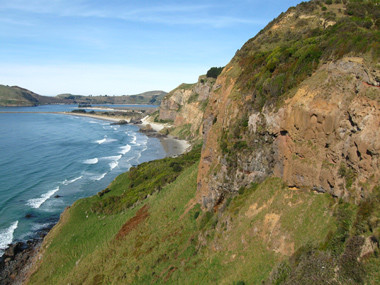
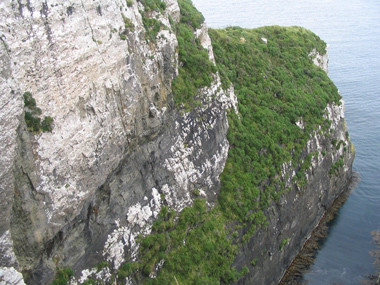 Cliffs are prominent in New Zealand because of tectonic upheaval of hard rocks by folding, faulting and uplift. Cliffs are also an erosional feature resulting from the down-cutting of rivers and the solution (chemical) weathering of limestone strata. Plants experience an unusual set of selective pressures on cliffs (compared to those of surrounding forest): thin or no soils leading to immediate expression of the physical and chemical properties of the basement rock; sometimes an unstable footing because of crumbling substrates; little buffering by tall vegetation of extremes of air humidity; and, in prehuman New Zealand, no herbivory by large flightless birds. Adaptation to this exposed environment has produced an evolutionarily distinct flora. Also, plants specialised to cliffs have been genetically isolated by limited opportunities for pollen exchange and seed dispersal between adjacent habitats leading to species radiation and local endemism. False islet, Catlins (left) and Hayward Point Aramoana (right). Photos by John Barkla.
Cliffs are prominent in New Zealand because of tectonic upheaval of hard rocks by folding, faulting and uplift. Cliffs are also an erosional feature resulting from the down-cutting of rivers and the solution (chemical) weathering of limestone strata. Plants experience an unusual set of selective pressures on cliffs (compared to those of surrounding forest): thin or no soils leading to immediate expression of the physical and chemical properties of the basement rock; sometimes an unstable footing because of crumbling substrates; little buffering by tall vegetation of extremes of air humidity; and, in prehuman New Zealand, no herbivory by large flightless birds. Adaptation to this exposed environment has produced an evolutionarily distinct flora. Also, plants specialised to cliffs have been genetically isolated by limited opportunities for pollen exchange and seed dispersal between adjacent habitats leading to species radiation and local endemism. False islet, Catlins (left) and Hayward Point Aramoana (right). Photos by John Barkla.
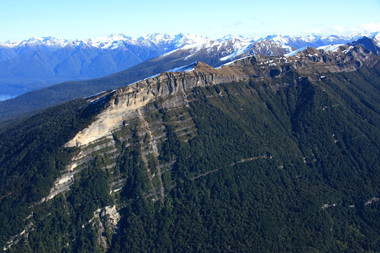
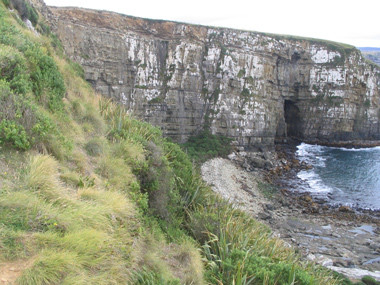 The cliff ecosystem has three broad bioclimatic zones: coastal, inland lowland, and inland upland. Plants of coastal cliffs tolerate high salt deposition, buffeting winds, and much seabird disturbance. Given the loss of seabirds since humans arrived, plants with ecological dependency on seabird guano feature prominently in the threatened plants of coastal cliffs, particularly in the genera Lepidium and Senecio. Examples of endemics restricted to Cook Strait’s coastal cliffs are the tall shrubs Carmichaelia muritai and Sophora molloyi. Coastal cliff, Long Point, Catlins (left, by John Barkla) and sub-alpine cliff, Turret Peak, Te Anau (right, by Geoff Rogers).
The cliff ecosystem has three broad bioclimatic zones: coastal, inland lowland, and inland upland. Plants of coastal cliffs tolerate high salt deposition, buffeting winds, and much seabird disturbance. Given the loss of seabirds since humans arrived, plants with ecological dependency on seabird guano feature prominently in the threatened plants of coastal cliffs, particularly in the genera Lepidium and Senecio. Examples of endemics restricted to Cook Strait’s coastal cliffs are the tall shrubs Carmichaelia muritai and Sophora molloyi. Coastal cliff, Long Point, Catlins (left, by John Barkla) and sub-alpine cliff, Turret Peak, Te Anau (right, by Geoff Rogers).
Inland lowland cliffs have formed in many rock types, particularly volcanic and hard and soft sedimentary types. However, a large threatened flora occurs on lowland limestone outcrops as part of the general farm clearance of the lowlands. A large number are endemics of Canterbury and Marlborough, although there are others restricted to the Waikato (e.g., Hebe scopulorum), Hawke’s Bay (e.g., Chionochloa flavicans f. temata) and Nelson (e.g., Parahebe senex and Hebe stenophylla var. hesperia).
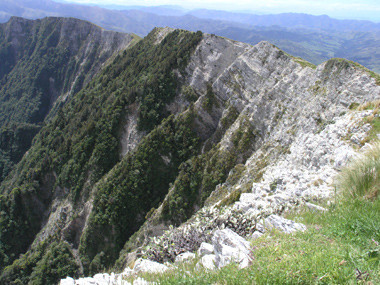 Inland lowland limestone cliff, lower ridge, Benmore, Marlborough. Photo by Geoff Rogers.Inland upland cliffs occur all along our axial ranges and mountains from montane elevations up. Few pure cliff specialists occur there because rocky habitats and polar climates are universal alpine factors. Cliff floras are richest in Nelson’s Tasman Mountains and the central Southern Alps, with Hebejeebie birleyi and Ranunculus grahamii two iconic cliff specialists in the latter zone.
Inland lowland limestone cliff, lower ridge, Benmore, Marlborough. Photo by Geoff Rogers.Inland upland cliffs occur all along our axial ranges and mountains from montane elevations up. Few pure cliff specialists occur there because rocky habitats and polar climates are universal alpine factors. Cliff floras are richest in Nelson’s Tasman Mountains and the central Southern Alps, with Hebejeebie birleyi and Ranunculus grahamii two iconic cliff specialists in the latter zone.
For more information see*:
- Basic cliffs, scarps and tors (Landcare Research)
*The Network is not responsible for the content of external internet sites
